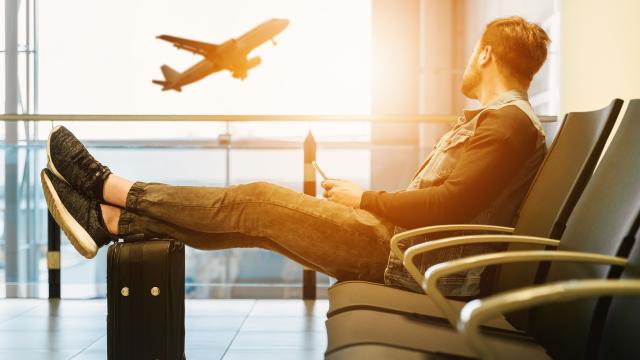It’s great to have a packing list for real world items, to make sure you don’t forget your underwear or your toothbrush, but what about a digital packing list? Make sure you have these electronic essentials before you travel so an internet blip doesn’t leave you confused or stranded.
But first, unpack
How much free space do you actually have, anyway? Take a look in your phone’s (and other devices’) settings, and clear out any large files you won’t need. You wouldn’t leave dirty clothes in your suitcase just because they were left over from your last vacation, so if you’re going to be short on digital space, delete your old photos and played-out podcasts.
If you use Google Photos, the menu has a “free up space” option that will delete from your phone any photos that it’s already backed up to the cloud.
Download maps
Google Maps can guide you just fine offline, if you’ve told it in advance which areas it should save. In the menu, tap “offline maps” and make sure that your destination and surrounding areas are covered.
Apple Maps and other apps have similar features, so make sure to download before you go.
Download languages
If you’re relying on language apps, make sure to download the languages you’ll need at your destination. In Google Translate, just tap the name of the language on your screen, and you’ll see a list of available languages with options to download them.
[referenced url=”https://www.lifehacker.com.au/2019/03/the-best-ways-to-use-google-translate-in-a-foreign-country/” thumb=”https://i.kinja-img.com/gawker-media/image/upload/t_ku-large/offotvic3l9z5e2nwj3s.jpg” title=”The Best Ways To Use Google Translate In A Foreign Country” excerpt=”If all you’ve ever done with Google Translate is copy-and-paste text, you’re missing out. The app can translate signs and menus visually, save your most-used phrases, and more.”]
Consider doing the same for language lesson apps, if you’re planning to study on the plane. For example, Duolingo’s premium subscription allows you to download lessons.
Load up on entertainment
If you listen to music through a streaming service like Spotify, download a few favourite playlists. Grab some fresh podcast episodes while you’re at it, and stock up on audiobooks, movies, or whatever else you might like to entertain you.
Install ride sharing apps
I don’t have much need for Lyft or other ride sharing apps when I’m at home, but as soon as I land in a new destination, I suddenly wish I hadn’t deleted them. Don’t be like me; install the app when you’re on wifi, and then when you land you can request a ride and be on your way.
Add airline and travel apps
Mobile Passport to breeze through customs when you re-enter the US.
Check for other apps that might be relevant to your destination. Sometimes conferences have their own app that provides up-to-date schedules and other handy info. Look for digital offerings from museums and other attractions; they might have an app, or you might find out when you check their website that you can get better ticket prices online than in person.
Back up digital and paper documents
Screenshot your boarding pass. Screenshot your hotel confirmation email. Screenshot your frequent flyer number, the contact information for every place you plan to go, and anything with a confirmation number.
If a document exists in meatspace, take a photo of it. You may need to fill out a form with your passport number later, or submit a receipt for reimbursement. I have a sticky note on the inside of my passport with my frequent flyer number and my TSA known traveller number. And then, in my phone, I have a photo of that page.
Be aware of where your photos get backed up, though. You may not want all of this info falling into the hands of somebody who steals your phone, so consider where you want to back it up, and whether you might want to set a reminder to delete everything when you’re on your way home.
[referenced url=”https://www.lifehacker.com.au/2018/10/how-do-you-back-up-your-data-in-the-cloud/” thumb=”https://i.kinja-img.com/gawker-media/image/upload/t_ku-large/hrfcrihtrfvdg51cdwsm.jpg” title=”How We Back Up Our Data To The Cloud” excerpt=”The subject of file backups and online storage came up the other day at a Lifehacker staff meeting, and resident door-holder Nick Douglas chimed in that his solution for backing up his laptop was easy: He never keeps any important files on it. Everything — and he means everything — lives in the cloud.”]
Photos of important objects
If you lose your luggage, a photo may help you get it back. If you become separated from your kids, pets, or travel companions, a photo of them will be handy too. Snap pics of your rental car to prove whether that scratch was there when you got it, and of your own car if you’ve parked in the airport lot.
I always try to get a shot that clearly shows my car, its licence plate, and the nearest parking sign so I can check my phone when I land and confidently walk straight to spot 13g.
[referenced url=”https://www.lifehacker.com.au/2018/09/take-photos-of-your-luggage-before-you-travel/” thumb=”https://i.kinja-img.com/gawker-media/image/upload/t_ku-large/xjn1ev6ayyy18bwfkfpi.jpg” title=”Take Photos Of Your Luggage Before You Travel ” excerpt=”When we mentioned last week that you should screenshot your boarding pass and other important travel documents, several readers chimed in with tips on real-world things to photograph as well.”]

Comments